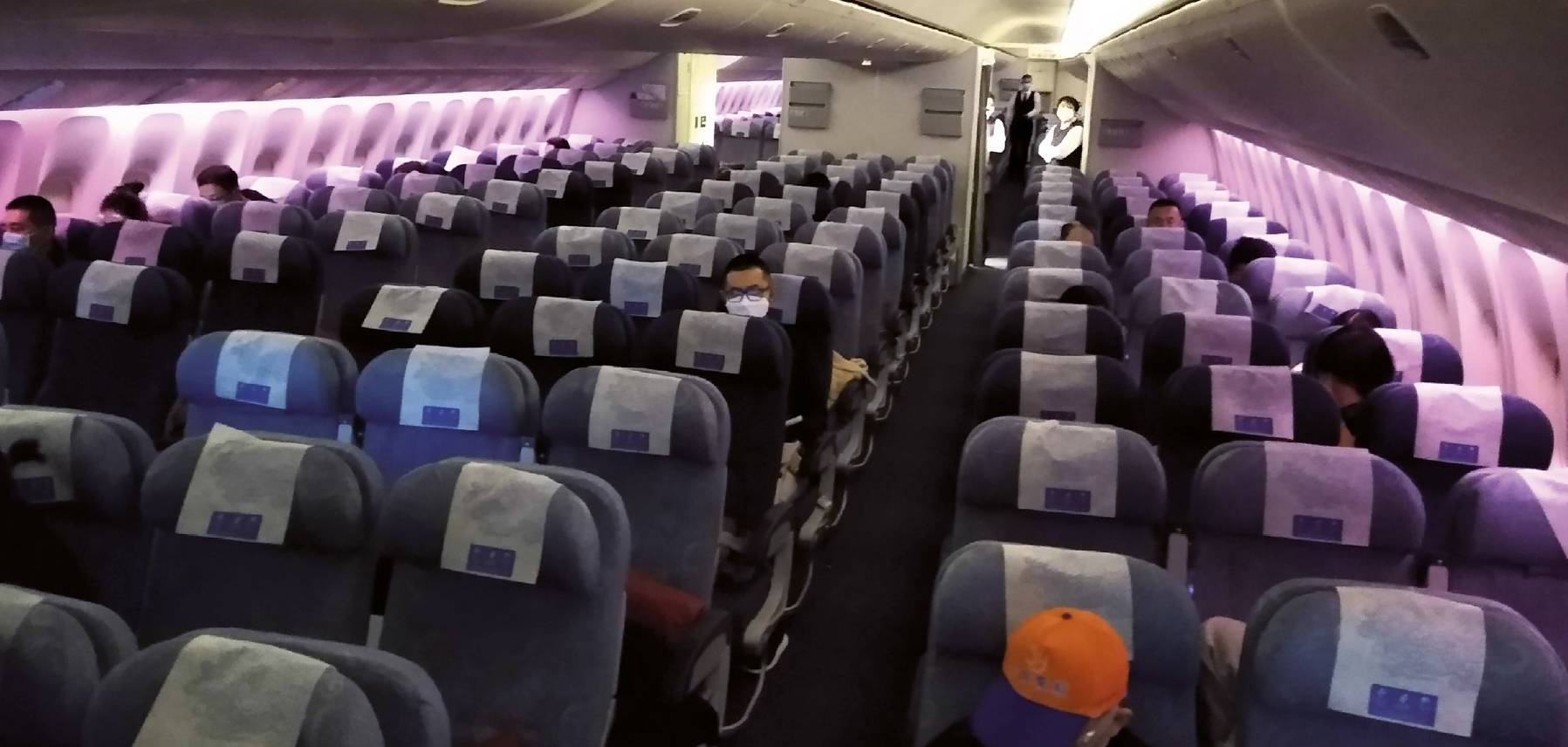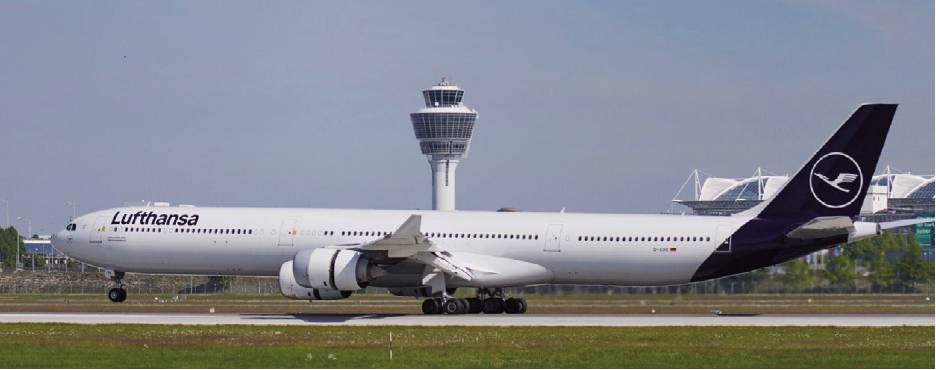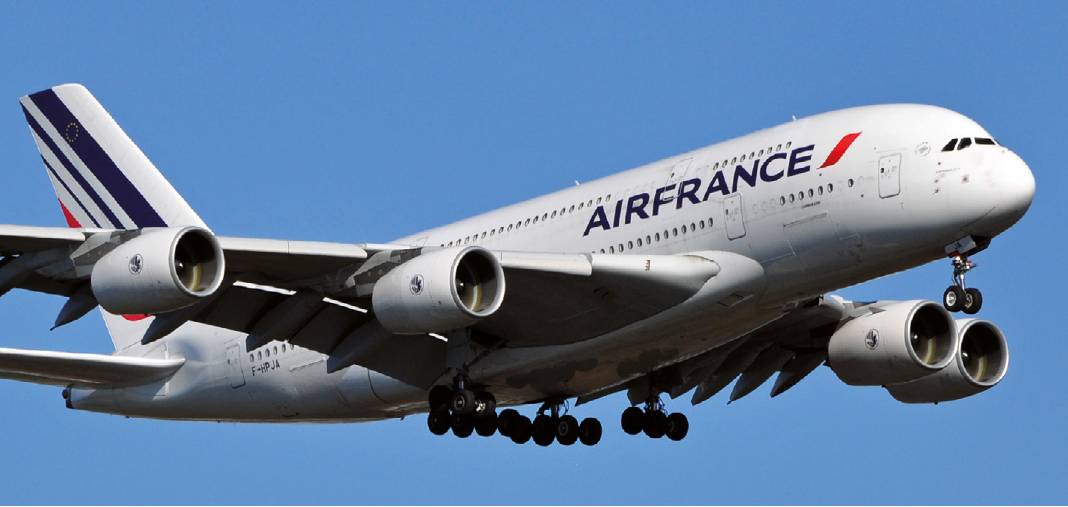AIR TRANSPORT Airlines and Covid-19
International airlines suffering from ‘long Covid’
Covid-19 has been with us for 18 months now and, just as the light at the end of the tunnel became visible, so a new Covid variant has set back a recovery. Prof KEITH HAYWARD FRAeS reports on how this is affecting the airline sector.
 A nearly empty flight from PEK to LAX in March 2020 amid the Covid-19 pandemic. Mx Granger
A nearly empty flight from PEK to LAX in March 2020 amid the Covid-19 pandemic. Mx Granger
One of the nastier features of Covid-19 is a lingering and debilitating illness – a description also perhaps of the pandemic’s impact on the international airline industry. Figures from the International Air Transport Association (IATA) revealed the extent of the damage: demand in early Spring was down 88.7% on 2019 levels, total losses were over $118bn and, more ominously for airline revenues, average load factors were 40% below normal. June numbers were slightly better, at 60% of 2019 levels. IATA is predicting total losses for the year of $48bn, 25% higher than earlier estimates. The US is coming out of the crisis better than expected, with predicted losses of only $5bn. On the other hand, Western European airlines could lose $22bn, double earlier predictions.
More positively, IATA recorded a rise in freight traffic, in some cases up by 3% on pre-crisis levels (11% in North America). This reflected a wider economic revival, as well as the shift in consumer patterns to e-commerce emphasising smaller, more frequent shipments. FedEx and UPS have seen quarterly revenues up by 20%. Air cargo is now responsible for 30% of airline revenue, compared to 12% in 2019.
The sector and some governments are exploring measures designed to restore confidence in air travel through rapid testing, vaccination passports, ‘air corridors’ and ‘green light’ destinations. However, there are still numerous, often draconian, restrictions in place. The emergence of new variants added to the woes facing airlines, airports and associated services. The rollout of vaccination programmes – better in some countries than others – has begun to help but the Delta variant, originating in India, has led to a setback in expectations of a general return to normality.
The United Kingdom
All of the major UK based or operationally significant airlines in the UK have gallons of red ink on their accounts this year. The IAG group, including BA, flew just a third of its normal scheduled flights and declared a record loss for 2020 of €7.4bn and BA cut 10,000 jobs. IAG raised €2.75bn from shareholders and government loans, but is losing money – €185m a month. Last year easyJet made the first loss in its history – £800m – and flew at about 25% of its normal capacity. To balance its books, it sold £608m worth of aircraft and cut 4,500 jobs. It also took up a UK government loan of £600m and raised more money from shareholders. Losses continued into the first quarter of 2021 but the airline has detected a ‘pent up’ demand for seats.
 British Airways customers now have access to discounted Covid-19 PCR tests administered by a testing specialist in their own home. British Airways
British Airways customers now have access to discounted Covid-19 PCR tests administered by a testing specialist in their own home. British Airways
British airports are not doing much better; some of the smaller locations have suffered from total closure pro tem. Passenger numbers were down 98% at Heathrow during the first national lockdown in April 2020 and 30% of its workforce has been made redundant. Traffic is still running at 1966 levels. Gatwick posted a loss of £465m. Many others in the ancillary and supporting businesses have been similarly affected. Passenger numbers for Manchester Airport Group were down by a staggering 96.8%.
Direct help from the British government has been promised since the early days of the pandemic but nothing has so far been forthcoming. The government says it has provided £7bn to help the sector in terms of general business aids, such as funding furlough, business property tax reductions and loans. However, airlines, airports and aviation trade unions were united in calling for more help specifically for aviation. More aggressive voices, such as Ryanair’s Michael O’Leary, felt that the government’s lockdown measures, such as hotelbased quarantines, were too tough and it was too slow to relax restrictions on foreign travel.
Meanwhile, the airlines and travel companies are anticipating an end to these restrictions in the summer, announcing flexible-booking packages from June onwards. While the ‘unlocking’ of a few ‘green light’ destinations, such as Portugal in May, brought some good news, confusion over the government’s recommendations about ‘amber destinations’, which led to an abrupt return of Portugal to amber in June, expensive testing regimes and long delays at border checkpoints will not help recovery. A lot depends on the effects of the ‘Indian’ variant before the government will confirm the next stage of ‘unlocking’ international travel. Ominously, both France and Germany introduced strict controls on travel from the UK with high Delta variant cases.
Western Europe
According to Aviation Week, Europe has been the hardest hit of the world’s regions: heavy dependence on international traffic and spasmodic lockdowns has not helped. Eurocontrol data for April 2021 revealed the impact of a year’s pandemic effects: Air France operated 64% fewer flights for the same day in 2020, Alitalia 66%, KLM 59%, Lufthansa 82% and Ryanair 93%. Even DHL, with cargo somewhat protected by online purchasing, recorded 35% fewer flights. The major European airports had between 55% and 81% fewer movements.
This has gone straight to airline bottom lines: Lufthansa recorded its worst loss in its history last year – €5.5bn across all of its operations including Austrian and Eurowings. Its cargo business was the one bright spot, with a profit of €772m on the back of Covid-related freight operations. The airline has cut 30,000 jobs with more to follow and plans to retire 100 aircraft. Lufthansa is predicting that a recovery of sorts will be underway by the end of the year but it will still be operating at 90% of capacity by the mid-2020s. It has been helped by a €9bnrescue package from the German, Belgian, Swiss and Austrian governments. The German government also took a 20% stake in the business and is now the largest single shareholder. Air France-KLM racked up a €7.1bn loss and was able to tap aid from two governments. The French government also agreed to contribute up to €4bn in additional shares to strengthen Air France-KLM’s balance sheet, but The Hague was reluctant to join in the capital injection.
The European airport lobby group, ACI, has called for more help for struggling airports. In particular, the ACI wants the EU to relax its rules on state aids, so that governments can pay direct subsidies to save the network. Overall, EU airports received just €2.2bn in aid last year, a fraction of the support extended to airlines. If some European LCCs get their way over cuts to landing charges, the situation facing airports could get worse. The CAA blocked Heathrow’s proposed 7% increase but even the smaller increment authorised by the CAA annoyed airlines such as BA.
The United States
US domestic traffic was down 30% over the year, and international traffic fell by 43%, with passenger volumes down 40% and 60% respectively. However, airlines, airports and others in the aviation business have leveraged Federal Government assistance covering payroll and some other running costs under programmes initiated in 2020. The payroll support was worth $28.2bn. This support increased overall confidence and enabled companies to get credit on the open market. Some businesses reduced costs through furlough and early retirements. Airlines dumped older aircraft earlier than planned, reducing the number of airport destinations and used smaller aircraft. Some airports delayed capital expenditure on terminal modernisation and other expansion plans, while others took advantage of the reduced number of flights to work on modernisation programmes during normal hours, reducing overtime costs.
 Having retired its fleet of Airbus A340-600s, Lufthansa has now taken the decision to temporarily reactivate five aircraft to operate on some long-haul routes until the arrival of A350-900s in 2023. Lufthansa
Having retired its fleet of Airbus A340-600s, Lufthansa has now taken the decision to temporarily reactivate five aircraft to operate on some long-haul routes until the arrival of A350-900s in 2023. Lufthansa
The Trump Administration authored the $88bn CARES Act to help the sector recovery. Help included $32bn in payroll support for airline and cargo operators; $46bn for loans and guarantees to provide liquidity; and $10bn to airports of all sizes. Of the $21.2bn in Federal loans to airlines, nearly $20.8bn went to seven major carriers. Earlier this year, Congress authorised another $14bn in aid, taking total support to $63bn. The US government deliberately excluded cargo operators from much of the assistance programme, anticipating rightly that there would be an upsurge in demand for goods for both industry and consumer needs.
Overall, passenger traffic slumped to 20% of normal and, up to November, 122,600 jobs were cut permanently from the air transport sector. On the positive side, on the back of ten years of profitable operation, US airlines entered the crisis in reasonable shape. Full recovery is optimistically forecast for the mid-2020s but Covid-19 effects could linger much longer.
The US is currently looking at ways of adjusting its support programmes to cover areas of the sector that have suffered most from the downturn and airline cost cutting. This is focused on support for airports and communities that may have entirely lost access to the network. Other measures under consideration include support for infection checking and controlled boarding procedures. As of March this year, traffic year-on-year is still 33% down. In the meantime, all of the big carriers are losing money. As a condition of the support to airlines, the US government has ‘rights to buy’ shares, which could imply between 8 and 20% of the four main airlines, although how much these stakes would be worth depends very much on the rate and depth of the recovery.
As elsewhere, recovery depends on factors well outside the control of airlines and airports. The vaccination programme is well on track and the US has had fewer restrictions on domestic travel than Western Europe. Summer bookings for US domestic flights are up to 86% of last year’s level but international long haul is still depressed, at 70% of 2020 operations. High premium corporate traffic has also been badly hit across the board. American carriers are increasingly hopeful of a strong domestic recovery through the summer. Buoyed by Federal support packages and an effective vaccination programme, the airlines believe that the worst might be behind them. The Biden Administration’s trillion-dollar economic stimulus and infrastructure investment packages will also add extra thrust to domestic air traffic. US carriers went into the current crisis in much better shape than in the 2008-9 recession but they will still need a speedy return to something approaching normal. The General Accountability Office (GAO) is going with 2023 as the most likely date for a return to 2019 traffic levels.
Latin America
With the exception of Chile, few of the region’s nations have come to terms with the pandemic. Brazil in particular is having an awful time and several countries have ‘red listed’ passengers from the country. Argentina and Panama sealed their borders to flights, and Mexico and Brazil only allow much reduced international flights. Few of the national carriers have received state aid and Chile’s LATAM Airlines, Aeromexico and Colombia’s Avianca are in bankruptcy restructuring.
The outlook generally for recovery in South America is clouded by pre-existing economic turbulence and political uncertainty. In March, Brazil recorded an upsurge in traffic but the continuing and increasing rate of Covid infections and deaths may lead to further curbs on flights. Currently, the country is operating a skeleton service and, even before the pandemic, overall, South American countries had tried to minimise restrictions on international travel but the knock-on effects of the growing Brazilian health crisis will begin to have a dampening effect on travel even within the region.
China
First into the crisis, China seems effectively first into recovery. After a bad year, economic growth is moving back on track and domestic air travel at least is more or less back to pre-Covid levels. Recovery in the Chinese market stalled following a prohibition on travel during the ‘Chunyun’ holidays but this should pick up into the summer months.
 The nearly empty international departures area at Beijing Capital International Airport. Mx Granger
The nearly empty international departures area at Beijing Capital International Airport. Mx Granger
The three largest carriers, Air China, China Eastern and China Southern, have opened new domestic routes, over ten in total. International travel remains depressed. But overall, Chinese airlines are financially in a better place than their foreign counterparts. This may put Chinese airlines in a strong position when international routes re-open. This relatively healthy position was helped by an extensive range of state support provided from March last year including additional investment in state-owned companies and other measures designed to encourage safe travel once lockdowns were lifted.
India and rest of Asia
Demand for air travel in India continued to grow in January, with airlines adding rather than cutting capacity. This move was backed by a steady increase in the number of people flying – around 5.5% compared to December. Load factors of between 64-70% are buoyed by limitations on flight frequency imposed by the Indian government. However, the crisis in Covid cases in April through June depressed these relatively promising numbers, leaving flights only 10% of 2019 numbers.
Singapore International Airlines saw revenue shrink by 76% last year, caused by a 97.7% fall in traffic. A recovery plan calls for another $4.6bn in bonds on top of some $13bn since April 2020. The airline believes that traffic will be back to 32% of pre-Covid levels by the summer.
Generally, international travel in the region is still stymied by the slow rollout of national vaccination programmes and widespread government caution in opening up frontiers. Hong Kong and Japan, as well as Australia and New Zealand have been reluctant to allow inbound traffic. Overall, domestic traffic rates are hovering around high single figures with international operations down to one or two per cent of 2019 levels.
 Air France, as with many other airlines, has reduced capacity by retiring aircraft fleets including the A380. Joe Ravi
Air France, as with many other airlines, has reduced capacity by retiring aircraft fleets including the A380. Joe Ravi
Middle East and Africa
Several countries in Africa and the Middle East eased government restrictions in the lead up to this spring. Israel has had a particularly successful vaccination campaign and may begin to fare well as a destination during the summer. The Gulf States have similar hopes but again bans on international travel in Europe or strict and expensive quarantine regimes could delay recovery. Nevertheless, Emirates Airways is believed to be looking for a government bailout. Further bad news may follow increased Covid rates in the Sub-Continent, affecting a key source of business for Gulf-based airlines.
The position in Africa is precarious given the relatively slow vaccination campaigns in most countries. However, with international travel bans less onerous than elsewhere, African international traffic held up better than might be expected but the most recent data show signs of emerging problems.
And the recovery?
A general recovery will be slow and subject to abrupt regional reversals. Higher premium business traffic may remain depressed as ‘work from home’ practices remain in place. IATA is currently forecasting that traffic will return to 51% of precrisis levels by the end of this year. A consensus points to 2023/4 before a full recovery might be expected. Eurocontrol, the European air traffic management organisation, puts full recovery in 2026 at the earliest. Generally, LCCs will come out of the crisis quicker than long haul operators.
COVID MAY YET HAVE A PERSISTENT AND DISRUPTIVE ROLE IN SHAPING THE FUTURE HEALTH AND STRUCTURE OF THE CIVIL AVIATION BUSINESS
US airlines are claiming that the ‘worst is behind us’, based on high rates of vaccination and some airlines have even detected a revival in business traffic. On the other hand, Qatar boss Al Baker thinks that the ‘worst is still to come’. This may reflect the different local context with the outlook for Gulf carriers tied to the course of the pandemic in South Asia and its effects on long haul travel generally. Recovery will depend on a general economic activity but also on the return of passenger confidence backed by targeted measures such as vaccination certification and ‘green light’ travel corridors. EASA and the European Centre for Disease Control has recommended noquarantine flights for vaccinated EU citizens.
However, as the virus continued to throw curve balls, IATA’s Willie Walsh slammed lack of progress on a US-UK agreement during the G7 Summit this June. This was almost entirely due to the surge in the more virulent Delta (Indian) variant now affecting most of the UK. The UK also had to dump Portugal from its green list of no-quarantine destinations as infections increased there. At the same time, however, Air France was preparing to resume transatlantic operations and other US and EU carriers are offering Covid-tested services. However, uncertainty remains over how many European states will allow American citizens entry. Canada is still insisting on strict controls. The most optimistic scenarios suggest that the summer season will slip into the autumn; a more dismal outlook suggests that full recovery will wait until 2022. At best, a patchy recovery in domestic traffic can be expected but long-haul international travel will remain stuck in recession for some time yet.
Governments may have to take up even more of the slack. IATA notes that government aid worldwide is nearly $200bn so far and thinks that another $80bn may have to be pumped into the sector to head off airline bankruptcies. If so, this would seriously penalise those airlines unable to access direct state aids, as well as differences between self-funding LCCs and legacy airlines. A number of commentators are concerned that it may prove difficult to wean some airlines off state aid, which might lead to renewed legal challenges to ‘subsidised’ carriers from less protected carriers.
Longer-term affects
One fall-out from the crisis has been the switching of route structures to take advantage of friends and family markets, or areas that have ridden the crisis in better shape. Virgin Atlantic, for example, has been picking up traffic from South Asia to the UK and also on services to Nigeria. Some routes have experienced 90% load factors. For example, Air France increased flight to Francophone destinations. US carriers also looked to SE Asia and South Africa for new routes. These trends might presage a permanent adjustment to some airline business models.
But hanging over the industry is the spectre of long-term and permanent changes in demand. As Willie Walsh, the IATA chief noted, continuing restrictions and their associated costs could have a commensurate dampening effect on air travel, just as the prohibition on carrying fluids and enhanced security measures became the ‘new normal’ after 9/11. Covid may yet have a persistent and disruptive role in shaping the future health and structure of the civil aviation business.
 A nearly empty flight from PEK to LAX in March 2020 amid the Covid-19 pandemic. Mx Granger
A nearly empty flight from PEK to LAX in March 2020 amid the Covid-19 pandemic. Mx Granger British Airways customers now have access to discounted Covid-19 PCR tests administered by a testing specialist in their own home. British Airways
British Airways customers now have access to discounted Covid-19 PCR tests administered by a testing specialist in their own home. British Airways

